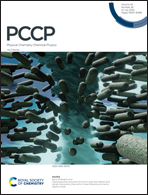Multipole-moment effects in ion–molecule reactions at low temperatures: part III – the He+ + CH4 and He+ + CD4 reactions at low collision energies and the effect of the charge-octupole interaction
Abstract
We present experimental and theoretical studies of the He+ + CH4 and He+ + CD4 reactions at collision energies in the kB·(0–10) K range. Helium atoms in a supersonic beam are excited to a low-field-seeking Rydberg–Stark state and merged with a supersonic beam of CH4 or CD4 using a curved surface-electrode deflector. The ion–molecule reactions are studied within the orbit of the helium Rydberg [He(n)] electron, which suppresses stray-electric-fields-induced heating and makes it possible to reach very low collision energies. The collision energy is varied by adjusting the velocity of the He(n) atoms with the surface deflector, keeping the velocity of the methane beam constant. The reaction product ions (C(H/D)p+ with p∈ {1,2,3}) are collected in a time-of-flight mass spectrometer and monitored as a function of the collision energy. No significant energy-dependence of the total reaction yields of either reactions is observed. The measured relative reaction rate coefficient for the He+ + CH4 reaction is approximately twice higher than the one for the He+ + CD4 reaction. The CH+, CH2+ and CH3+ (CD+, CD2+ and CD3+) ions were detected in ratios 0.28(±0.04) : 1.00(±0.11) : 0.11(±0.04) [0.35(±0.07) : 1.00(±0.16):0.04+0.09−0.04]. We also present calculations of the capture rate coefficients for the two reactions, in which the interaction between the charge of the helium ion and the octupole moment of the methane molecule is included. The rotational-state-specific capture rate coefficients are calculated for states with J = (0–3) at collision energies below kB·15 K. After averaging over the rotational states of methane populated at the rotational temperature of the supersonic beam, the calculations only predict extremely weak enhancements (in the order of ∼0.4%) of the rate coefficients compared to the Langevin rate constant kL over the collision-energy range considered.



 Please wait while we load your content...
Please wait while we load your content...